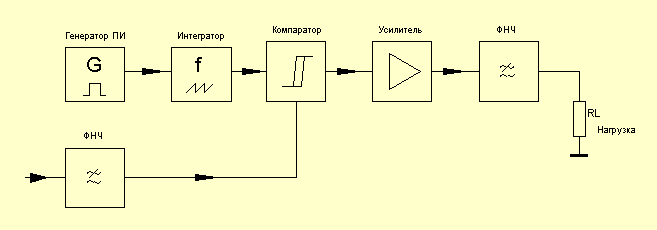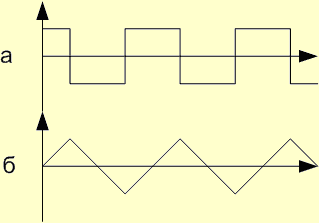
|
|
ENCYCLOPEDIA OF RADIO ELECTRONICS AND ELECTRICAL ENGINEERING Power amplifiers. Part two. Encyclopedia of radio electronics and electrical engineering
Encyclopedia of radio electronics and electrical engineering / Beginner radio amateur So in last time you and I settled on the fact that we got a hole of 1,4 volts, poured 20% of beer into the toilet and went out of grief to feed the Cat, who had spilled all the secrets. We continue. Next class AB. Actually, already from the name it is clear that this scheme for constructing the output stage is obtained by crossing an octopus with a hanger. That is, class A and class B. From the first we take a non-zero quiescent current I0>0. Thus, the bias voltage at the bases of the transistors is present. It is considered like this:
For those who just fell off the moon, I want to remind you that RL is the load resistance, and I0 is the required quiescent current. Well, from the class В we take everything else - since the quiescent current is very small compared to the output current (I0<<0,1ILmax), then the output, consumed, dissipated power will be almost equal to the power of the class В and are calculated using the same formulas
In general, by mixing these two ways of building output stages, we achieve a significant reduction in non-linear distortion on the one hand (see picture) with quite decent power and efficiency on the other. Most modern household amplifiers work in this class, and as for integrated amplifiers, that is, microcircuits, that's all. True, with one exception, which is discussed below. For now, let's summarize what we have with these three classes.
So the class А - excellent linearity, almost complete absence of non-linear distortions, but absolutely unbearable power characteristics, especially in terms of consumption and heat dissipation. In short - if you want a stove, make a class A output stage. Class В - eats little, very little. But at the same time, the output signal is so hooked that it would be better to do nothing at all. Class AB - a compromise solution between the two previous classes. All the best from one and the other is taken. It seems that everyone is satisfied with the price / quality ratio, with the exception, of course, of terrible people - audiophiles. They prefer it hot. Of course, the matter is not limited to these three classes - there are, for example, such exotic modes as A + or G, but we will not consider them, due to their extremely low prevalence. Particularly curious comrades can pick up their noses in literature or the Internet. Well, we will ride on while the Cat is sleeping. All the amplifiers discussed above were linear amplifiers, despite all the liberties in handling the signal entrusted to them. That is, these circuits do not intentionally distort the input signal before amplifying it. Now we will consider a class of amplifiers that deliberately distorts the input signal, and after amplification restores it to its original form. This is the class D. (Meow! Cool class!) From the same, the Cat was awakened. Generally speaking, the class D - this is not only a construction scheme or an operating mode of the output stage - this is a whole separate class of amplifiers. But since the Cat has blabbed about it, you will have to shove it all into a conversation about the output stages. To begin with, consider the general block diagram of the amplifier. Let's quickly run through the blocks disfigured in the figure. PI generator - a rectangular pulse generator produces rectangular pulses with a fixed frequency Fs (graph а) that arrive at integrator, where they are converted into triangular or sawtooth pulses (graph б), after which they arrive at one of the inputs comparator.
The other input of the comparator receives the input audio signal from the source. This is where the main meat grinder called PWM (pulse width modulation) or PWM (pulse-width modulation) if in a bourgeois way. Let us dwell on the work of the comparator, for which we look at the picture.
So, as already mentioned, one input of the comparator receives triangular pulses from the generator (blue in the picture), and the other input receives an audio signal that needs to be amplified (something red in the picture, similar to a sinusoid). Then the comparator does the following: if the current (instantaneous) value of the "saw" level exceeds the value of the input signal level, the comparator switches to a low logic level, if vice versa - the level of the "saw" signal is less than the audio signal, then the comparator switches to a logical unit. Of course, all this happens in one clock cycle of the generator (that rectangular one). Thus, at the output of the comparator, we get a rectangular signal, the pulse width of which depends on the amplitude of the input signal, and its frequency is equal to the frequency of the master oscillator Fs - this is SHI modulated signal. In fact, the sawtooth pulses are drawn so rarely in the picture solely for clarity. In fact, the frequency of these pulses is 10-20 times higher than the maximum frequency of the audio signal. Usually it is selected in the range of 200-500 kHz. Further, the modulated signal is fed to a power amplifier based on field-effect transistors, which operate in the switch-mode. After the amplifier, a low-pass filter is inserted, which filters out the high-frequency component of the signal and restores the analog signal, which is then reproduced by the load. Now let's see what all these dances are for. First of all, to efficiency. Theoretically, the efficiency of such amplifiers should reach 100%, but unfortunately, the resistance of the transistor channel, although small, is still non-zero. But nevertheless, depending on the load resistance, the efficiency of amplifiers of this type can reach 90% -95%. Of course, with this efficiency, there is practically no heating of the output transistors, which allows you to create damn small and economical amplifiers. The coefficient of harmonic distortion with proper construction of the output low-pass filter can be brought up to 0,01%, which is very, very worthy. Amplifiers of this class are produced, like AB, in an integrated design. Well, for now, this is all I wanted to talk about the final cascades, then we have plans for pre-amplification cascades - what they are, what they are eaten with and ... Publication: radiokot.ru
Machine for thinning flowers in gardens
02.05.2024 Advanced Infrared Microscope
02.05.2024 Air trap for insects
01.05.2024
▪ The thermal trail will reveal the pin code of the smartphone ▪ Super solar flare could destroy all electronics on Earth
▪ section of the site Your stories. Article selection ▪ article by James Rosenquist. Famous aphorisms ▪ article What are reactive streams? Detailed answer ▪ article Physical education teacher. Standard instruction on labor protection ▪ article Lacquer for rubber galoshes. Simple recipes and tips
Comments on the article: Eugene A very good article.
Home page | Library | Articles | Website map | Site Reviews www.diagram.com.ua |






 Arabic
Arabic Bengali
Bengali Chinese
Chinese English
English French
French German
German Hebrew
Hebrew Hindi
Hindi Italian
Italian Japanese
Japanese Korean
Korean Malay
Malay Polish
Polish Portuguese
Portuguese Spanish
Spanish Turkish
Turkish Ukrainian
Ukrainian Vietnamese
Vietnamese






 Leave your comment on this article:
Leave your comment on this article: